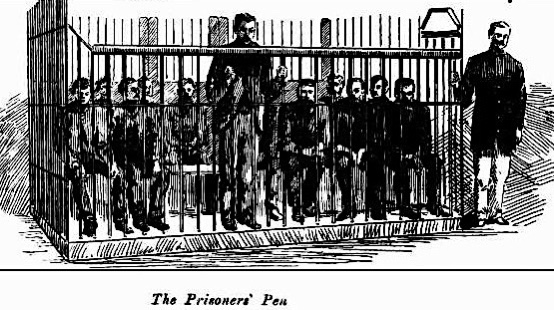Governor Arthur Phillip in 1792 defined the boundaries of settlement: east of the Tank Stream were the residences of the Governor and civil authorities; west of the Tank Stream were the military barracks, parade ground and hospital. The convicts, however, began to occupy the sandstone ridges (The Rocks) above Sydney Cove's western foreshores.
Susannah Place Museum is a historic house museum,
situated in The Rocks, Sydney. It is a block of four terrace houses built for four working-class Irish immigrants in 1844.
Edward and Mary Riley arrived from Ireland with their niece Susannah in 1838. Their house is typical to the area, of brick and sandstone houses and features a basement kitchen and backyard outhouse.
 |
| The Rocks from Government House, NSW, circa 1858, courtesy of the City of Sydney Archives |
"I have never seen such a
miserable class of houses as that on The Rocks. I know two or three houses which are not larger than this room, two or three families living in one house."
– 1859 Select Committee on the Condition of the Working Classes
These four houses, now Susannah Place Museum, were home to more than 100 families over nearly 150 years.
The buildings have survived numerous demolition threats. In 1900, a Bubonic plague led to hundreds of neighbouring properties being demolished. Then, in the 1920s, a three-street-wide-section of The Rocks was cleared to make way for the Harbour Bridge approaches.
 |
| WIPING OUT THE SLUMS. Amount The Rocks at Miller's Point, NSW,Daily Telegraph (Sydney, NSW : 1883 - 1930), Friday 30 October 1908 |
In the 1970s, we can be thankful for the "Green bans" imposed by the Builders Labourer's Federation, which stopped may demolitions and redevelopment projects. These irreplaceable buildings would have been
lost forever.
Sydney Cove is part of the lands of the Cadigal people of the Eora nation. However, the absence of an archaeological record for the Cadigal (even allowing for large-scale city development) has led Emeritus Professor Grace Karskens to believe that Sydney Cove was likely to be border country for the Eora nation, and therefore, may not have been
inhabited prior to European settlement.
Around Susannah Place Museum
 |
| Susannah Place Museum, The Rocks, NSW |
 |
| Susannah Place Museum, The Rocks, NSW |
 |
| Susannah Place Museum, The Rocks, NSW |
 |
| Susannah Place Museum, The Rocks, NSW |
Things To Do
Susannah Place Museum
Address: 58/64 Gloucester St, The Rocks NSW 2000
Telephone: 0292411893



























